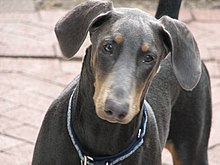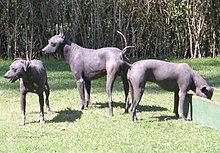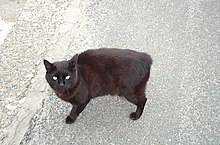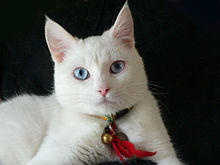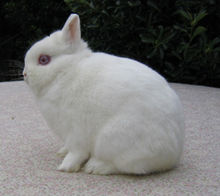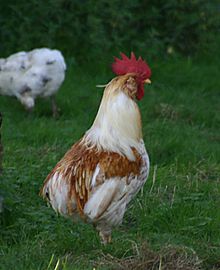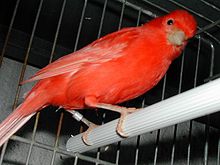List of the affected features of the report on the interpretation of the prohibition of torture breeding
This list contains extracts of the characteristics of pet animals that are described in the expert opinion on the interpretation of Section 11 b of the Animal Welfare Act (prohibition of torture breeding ) . The report of June 2, 1999 refers to § 11 b of the Federal German Animal Welfare Act in the version of the announcement of May 25, 1998 and was drawn up by a group of experts appointed by the Federal Ministry of Agriculture. “The report is intended in particular to help all pet animal breeders to meet their responsibilities and to fully comply with the provisions of the Animal Welfare Act, which concern breeding. The goal is the vital, healthy, pain and suffering-free animal. "(Report p. 1)
dogs
Blue dog syndrome (blue Doberman syndrome)
- definition
- Blue-gray lightening with a predisposition to alopecia and skin inflammation. Pigment Deficiency Syndrome.
- Occur
- Sporadic, family-run with Dobermann , Greyhound , Irish Setter , Teckel ,
- genetics
- Autosomal incompletely dominant.
- Symptoms
- A disturbed keratinization of the hair follicle epithelium leads to hair loss with flaking, papules and pustules, as well as secondary follicular pyoderma. The lymphatic system can change, edema and adrenal dysplasia can develop. The basis of the defect is an adrenal insufficiency with an immune complex disorder. Homozygous animals are apparently more affected than heterozygous animals (incompletely dominant).
Brachy and anuria as well as crippling of the caudal spine

Stubby tail of an Entlebuch mountain dog
- definition
- Different degrees of shortening of the caudal spine up to the stump tail, with or without crippling of the tail (kinked tail, corkscrew tail).
- Occur
- Sporadically, in families with French bulldogs , English bulldogs , pug , dachshund , bobtail , cocker spaniel , Entlebuch mountain dog , rottweiler
- genetics
- Kink and corkscrew tails autosomal recessive, brachy and anuria probably autosomal recessive, etc. U. polygenetic, possibly with an environmental factor.
- Symptoms
- Kinked and corkscrew tails and shortening of the caudal spine often occur with deformities in other sections of the spine (block, butterfly and wedge-shaped vertebrae, spina bifida). This can result in disturbances in the movements of the hind limbs up to paralysis, as well as urinary and fecal incontinence.
Chondrodysplasia
- definition
- Dwarfism with shortening of the long bones so that the limbs. Possibly the cause is a hormonal malfunction of the calcium and phosphate metabolism.
- Occur
- Basset , French Bulldog , Pekingese , Scottish Terrier , Sealyham Terrier , Welsh Corgi
- genetics
- Seemingly autosomal incompletely dominant.
- Symptoms
- Strong disposition to premature malformation of the intervertebral discs, which can lead to a herniated disc.
Dermoid / dermoid cysts
- definition
- Skin protuberances on the back that can extend into the spinal canal.
- Occur
- Rhodesian Ridgeback , Thai Ridgeback
- genetics
- Probably autosomal incompletely dominant with coupling to the gene “Ridge” (hairline with opposite growth).
- Symptoms
- In front of and behind the "ridge", cysts appear on the back, which develop in the embryo from an imperfect or no separation of skin and spinal cord. If the connection to the spinal canal and spinal cord remains, this can lead to paralysis of the hind legs and sensitivity to pain. In addition, infections cause inflammatory changes (meningitis, myelitis).
Gray Collie Syndrome
- Definition: Silver-gray lightening, associated with a disorder of blood formation.
- Occur
- Different collie breeding lines
- genetics
- Autosomal recessive with semiletal factor
- Symptoms
- The disruption of blood formation (reduction in neutrophil granulocytes) creates a strong predisposition to infections, especially of the mucous membranes. The lack of defense against infection often leads to death before sexual maturity.
Hairlessness
- definition
- Hairlessness
- Occur
- Chinese hairless dog , Mexican hairless dog
- genetics
- Autosomal incompletely dominant with lethal / semi-lethal factor
- Symptoms
- Serious dentition abnormalities, missing premolars, canini or incisors. Immunodeficiency, sensitive skin (sunburn, allergies, injuries, fly infestation) and climatic adaptation disorders.
Merle Syndrome
- definition
- Tigung in homozygous animals: "White tiger". Depigmentation with variably pronounced sensory organ defects.
- Occur
- Bobtail , Collie, Great Dane , Dunker , Sheltie , Teckel , Welsh Corgi .
- genetics
- Autosomal incompletely dominant, sub-vitalgae.
- Symptoms
- In homozygous animals, 50% to 100% of the body surface is unpigmented. There are also anomalies of the eyes and ears, therefore more or less impaired vision and hearing. In addition, disorders of the organ of equilibrium and reproduction occur. White tigers have a perinatal mortality rate of up to 47%.
Brachycephaly / Brachygnathy
- definition
- Wide, round skull up to a primate-like round head and / or shortening of the jaw and nose bones
- Occur
- German Boxer , Bulldogs , Chihuahua , Pug , Pekingese , King Charles Spaniel , Shih Tzu , Toy Spaniel,
- genetics
- Polygeny
- Symptoms
- Hard births. In brachycephaly and chondrodysplasia, tendency to brain tumors and hydrocephalus. With a higher degree of dwarfism, the thickness of the roof of the skull decreases, combined with persistent fontanelles, which can lead to skull injuries. The disproportionate growth of the skull bones reduces the size of the sinuses, stenoses appear in the nostrils and passages, and the palate becomes too long and soft. The consequences are breathing difficulties and disorders of thermoregulation as well as swallowing difficulties. A pronounced undershot bite can also cause the teeth to function poorly.
Ectropion
- definition
- Outward rolling of the lower edge of the eyelid.
- Occur
- Heaped with basset , St. Bernard , bloodhound , bulldog , cocker spaniel , Newfoundland dog , Shar-Pei
- genetics
- Polygeny with disposition for wrinkled skin.
- Symptoms
- The lid closure remains incomplete due to the outward turning of the lower lid margin. This leads to lacrimation, conjunctivitis, and possibly changes to the cornea.
Entropion
- definition
- Inward rolling of the edge of the eyelid.
- Occur
- In particular bull terrier , chow chow , poodle , rottweiler , mountain dog and shar pei , but also in many other breeds.
- genetics
- Probably polygenic, familial accumulation in breeds with deep-set and / or small eyes.
- Symptoms
- The inwardly rolled lower or upper edge of the eyelid leads to secondary trichiasis with corneal and conjunctival irritation up to conjunctivitis and keratitis.
Excessive, permanent skin wrinkling
- definition
- Skin folds that appear partially or everywhere.
- Occur
- Partial wrinkling in the Pekingese and Toy Spaniel, generalized wrinkling in the basset hound , bloodhound and especially Shar-Pei .
- genetics
- Probably polygeny.
- Symptoms
- Disposition to mucinosis and dermatitis, in brachycephalic races also irritation of the cornea with keratitis as a result.
Hip Dysplasia (HD)
- definition
- Poor development of the hip joint.
- Occur
- With heavy breeds such as St. Bernard , German Boxer , Great Dane , German Shepherd Dog , Leonberger , Mastiff , Newfoundland , Retriever , Rottweiler , Mountain dog , but sometimes also with smaller breeds.
- genetics
- Polygeny.
- Symptoms
- The bony joint parts ( acetabulum , caput femoris) are only insufficiently developed. The joint becomes unstable, deformation of the femoral head, osteoarthrosis and capsular contracture can occur with spontaneous painful lameness. The pain comes from the muscles trying to stabilize the joint again.
Hypertrophy of aggressive behavior
- definition
- Excessive attack and fighting behavior that is easily triggered and biologically meaningful neither in terms of purpose nor goal.
- Occur
- Can basically occur in many breeds.
- genetics
- Unexplained. It is questionable whether it is genetically determined.
- Symptoms
- Every social contact is answered with aggression and damage biting. The resistance to biting against social partners cannot develop; Certain breeding lines of the Bull Terriers, American Staffordshire Terriers and Pit Bull Terriers are also said to be affected.
Cats
Short-tailed or tail-less
- definition
- Different degrees of shortening of the caudal spine: Shortened, rolled up tail, straight, short tail (tailed), stumpy tail (stumpy), tailless with a small indentation instead of the tail (rumpy)
- Occur
- Occurs sporadically in all cat populations, but especially in Manx , Cymric and the various bobtail breeds.
- genetics
- Autosomal incompletely dominant, Gene + M and M (not clarified in Bobtails)
- + M + M "wild type" with tail
- M + M tail shortening of various forms
- MM lethal (early embryonic death)
- Symptoms
- The tail serves as a "balancing bar" when running, jumping and climbing as well as a means of communication. In the case of short-tailed or tail-less tails, movement disorders are to be expected and social communication is disturbed. In Manx cats, vertebral malformations are often to be expected, regardless of the "tail type" (tailed, stumpy, rumpy), and they are prone to massive defects in the pelvis and spinal cord, with neurological deficits in the rectum. Tailless animals are often sensitive to pain in the pelvic area.
Lightening of the color of the fur and iris, numbness
- definition
- Lightened to white fur, eyes often blue.
- Occur
- In pure white or predominantly white piebald animals:
- Turkish Angora, Persian, Foreign White (Siam, OKH), Russian White (Russian White), Turkish Van;
- Acromelanie at Siam and Colourpoint
- genetics
- W-series (epistatic white, covers all other colors): autosomal dominant, shows incomplete penetrance for hearing impairment
- C-Serie (Points): Autosomal recessive
- c
- pure albino with red eyes (practically not found in cats)
- cs
- Siamese acromelanism, pigmentation is limited to the ends of the body (legs, ears, face, tail)
- cb
- Burmese factor, weakens the pigmentation, the "points" are darker
- S series (more or less extensive white spotting): incompletely dominant
- I-series (color lightening of the lower hair shaft by inhibitor gene, “silver”): autosomal dominant
- Symptoms
- The W gene, in particular, causes hearing loss or deafness. Thoroughbred cats are deaf to approx. 43%, mixed breed cats approx. 27%. The perception of sounds is important for social behavior and catching prey. Deaf cats cannot hear approaching and threatening noises from their conspecifics or the whining and purring of the puppies. In blue-eyed animals z. T. impaired night vision. Point cats are prone to squinting and trembling eyes. Pied animals can also show inner ear defects (hearing loss). White cats are generally prone to skin tumors.
Outer ear abnormality (tilted and folded ear)

White Scottish Fold Cat
- definition
- Auricles are bent forward or backward
- Occur
- Scottish and Highland fold, poodle , American curl
- genetics
- Autosomal incompletely dominant, gene Fd
- Symptoms
- Damage to cartilage and bones occurs. Social contact with ears as signaling devices is limited.
Anomaly / deviation of the coat

Rex cat with abnormal fur structure, here a Cornish Rex
- definition
- Hair growth is disturbed or not available. Whiskers are shortened or missing.
- Occur
- Rex cats and Sphinx have deliberately abnormal coats. Especially with Devon-Rex and Sphinx the whiskers are curled or missing.
- genetics
- R series: Autosomal recessive rx genes of the Rex cats (x stands for the different genetic locations of the different breeds)
- H series: Autosomal recessive h, hd or hr genes of the Sphinx
- Symptoms
- A lack of keratinin leads to hair breakage and partial hairlessness. The whiskers are necessary for orientation, especially in the dark, and are also needed for catching prey and for social contacts.
Chondrodysplasia
- definition
- Dwarfism with shortening of the long bones so that the limbs.
- Occur
- Munchkin (dachshund cat)
- genetics
- Not clearly understood, could be autosomal dominant with incomplete penetrance. But possibly also polygenetic.
- Symptoms
- The limbs are significantly shortened. Changes in the intervertebral discs and intervertebral disc problems are to be expected.
Polydactyly (multiple fingers)
- definition
- Extra toes.
- Occur
- Occurs sporadically in all races, more common in Maine Coon.
- genetics
- Autosomal dominant with variable expression (different number of additional toes), gene Pd, semiletal factor
- Symptoms
- Excess toes can also be "invisible", which can lead to U. can lead to inflammation through fused claws.
Brachycephaly
- definition
- Large, round head, short, wide nose, pronounced stop. As an extreme, a snub nose, in which the upper edge of the nasal mirror lies well above the lower edge of the eyelids (Peke-Face).
- Occur
- Persian and Exotic Shorthair
- genetics
- Polygeny is suspected.
- Symptoms
- Difficult births (large head), higher stillbirth rate, shortening of the upper jaw, narrowing of the upper airways, narrowing of the tear ducts
Entropion
- definition
- Inward turning of the eyelid rim.
- Occur
- Sporadic in all races, more common in brachycephalic races.
- genetics
- Polygeny, predominantly related to brachycephaly.
- Symptoms
- The twisted upper or lower eyelid margin leads to irritation of the cornea and conjunctiva. Conjunctivitis and keratitis are the result.
Rabbits
Spot check
- definition
- Dot pattern of the otherwise white fur.
- Occur
- Scheckenkaninchen ( English piebald , German giant piebald , Rhenish piebald , ram's peck , small piebald , white hotot ).
- genetics
- Autosomal incompletely dominant, with modification genes, therefore very variable. Semiletal factor.
- Symptoms
- With increasing age the disposition to severe intestinal disorders. Hypertrophy of the adrenal cortex, which suggests increased permanent stress.
Dwarfism
- definition
- Extreme dwarfism.
- Occur
- Dwarf breeds such as ermine rabbits and colored dwarfs .
- genetics
- Autosomal incompletely dominant (gene Dw), lethal factor.
- Symptoms
- Many dispositions to illness. Increased disposition to brachygnathy (tooth position anomaly in the upper and lower jaw). Compression stenosis of the tear nasal canal in the area of the tooth roots results in tear drainage disorders.
Brachygnathia (shortening of the jaw)
- definition
- Shortening of one jaw compared to the other, usually the upper jaw (brachygnathia superior).
- Occur
- Especially in dwarf rabbits .
- genetics
- Not clarified.
- Symptoms
- Due to the shortening of the jaw, there is insufficient abrasion of the incisors. Food intake is restricted. Usually in ball-headed animals, the tear nasal canal is occasionally blocked, which leads to tear drainage disorders.
Birds
Laughing dove
Silky plumage
- definition
- No closed spring vane is formed, as the rays of the partly twisted spring branches are not interlocked.
- Occur
- Breeding form of the domesticated laughing pigeon.
- genetics
- Autosomal incompletely dominant.
- Symptoms
- Deformation of the hook rays as well as insufficient stability and elasticity of the spring rays, which also tend to twist. The flight ability of heterozygous animals is therefore restricted, homozygous animals are unable to fly.
Domestic pigeon
Short-billedness
- definition
- Extreme shortening of the upper and lower beak.
- Occur
- Diverse races.
- genetics
- Probably polygeny.
- Symptoms
- Problems with hatching due to misshapen or missing egg teeth. Favoring beak malformations.
"Almond"
- definition
- More or less pronounced multicolored plumage.
- Occur
- In numerous domestic pigeon breeds.
- genetics
- Sex-linked, presumably Z-linked incompletely dominant.
- Symptoms
- Pre- and postnatal deaths in homozygous animals. Survivors are nearly white and usually show severe damage to the eyes. In heterozygous animals in connection with color-thinning genes, reduced vitality and disturbances in movement.
"Dominant Opal"
- definition
- In heterozygous animals the color of the feathers is lightened and the large plumage is bleached.
- Occur
- In numerous domestic pigeon breeds.
- genetics
- Autosomal incompletely dominant with variable expressivity. Lethal factor.
- Symptoms
- Surviving homozygous animals show severe head tremors and usually do not reach sexual maturity. Heterozygosity does not appear to cause defects.
Unphysiological position of the intertarsal joints
- definition
- Stretched intertarsal joints.
- Occur
- Characteristic of various races.
- genetics
- Not clarified.
- Symptoms
- Disposition for degenerative joint diseases.
Fletching of the legs and toes
- definition
- Foot fletching in numerous degrees of expression. The size and shape vary considerably.
- Occur
- Numerous domestic pigeon breeds.
- genetics
- In the case of strong “licking” polygeny of the “grouse” and “slipper” genes. These individually only ensure a sparse foot feathering.
- Symptoms
- Heavily hit animals are comparatively clumsy and prone to the weather when kept free-flying. Parasite infestation is favored. Nestlings can get caught on the feathers and fall out of the nest (which is why their parents' feet are cut off before brooding). Mechanical damage to the pine feathers can cause bleeding.
Hypertrophied imposing behavior
- definition
- Excessive inflation of the goiter with air.
- Occur
- Name-giving feature of the piter ("Kröpfer").
- genetics
- Not clarified.
- Symptoms
- Impaired goiter physiology. Disposition to goiter wall infections as a result of incorrect fermentation, acidification and putrefaction of the goiter contents.
Hypertrophied growth of the beak nipples and dark circles
- definition
- Noticeable change in the nasal wax skin and the orbital rings with permanent increase in size.
- Occur
- Particularly pronounced with "Indian" and "Carrier".
- genetics
- Not clarified, but certainly genetically determined.
- Symptoms
- Due to the restriction of the field of vision in older animals, they can no longer fix the food optically. The waxy skin remodeling can restrict breathing. Inflammation develops in the wart folds. Older animals are often no longer viable and must be killed.
Tremors
- definition
- Jerky jerking back of the head and neck.
- Occur
- Different breeds, required in the breed standard for “Stargarder trembling necks”.
- genetics
- Presumably autosomal dominant with incomplete expressiveness.
- Symptoms
- The movement is strikingly rigid. The anatomical physiological basis of the disorder has not been clarified.
Deviating flight behavior (flight rolls, flight tumbling, ground rolls etc.)
- definition
- "Roll" or "tumble" during courtship flight of the rock pigeon.
- Occur
- Numerous races.
- genetics
- Probably autosomal recessive, with variable expressivity due to modifying genes.
- Symptoms
- Due to the great loss of height on the "roles", under certain circumstances impact on an obstacle with fatal consequences. "Bodenpurzler" races show the flight roll on the ground, since they are almost flightless.
Spring bonnets and spring swivels
- definition
- Local feathering anomaly in the head and neck plumage.
- Occur
- Numerous races.
- genetics
- Autosomal recessive. Presumably autosomal dominant in wig pigeons.
- Symptoms
- Visual obstruction by "part roses" and "beaked carnations".
Budgie
Spring bonnet
- definition
- Local feathering anomaly in the head plumage.
- Occur
- Standardized variant for show budgies.
- genetics
- Autosomal incompletely dominant with variable expressivity., Subvital factor.
- Symptoms
- Total mortality in pure and mixed breed animals 48%. Embryos die from cerebral haemorrhage. Viable animals show numerous abnormalities such as muscle tremors, balance and coordination disorders, behavioral defects due to abnormal brain enlargement. Significantly smaller egg and clutch sizes in homozygous animals.
"Look Budgerigar"
- definition
- Noticeable body size, head width and head rounded compared to the wild type.
- Occur
- Standardized breeding goal for show budgies.
- genetics
- Probably polygeny.
- Symptoms
- Due to increased body mass and size, a certain lethargy arises. Courtship and reproductive activities as well as the fertilization rate are reduced. Lower life expectancy compared to the normal type. A pronounced head fletching results in a restricted field of vision.
" Featherduster "
- definition
- Abnormal feather growth.
- Occur
- Highly bred lines of show budgies.
- genetics
- Presumably autosomal recessive.
- Symptoms
- The feathers are sometimes six times longer than normal. As a result, severe visual impairment and almost complete inability to fly. Very short lifespan (approx. 9 months) probably due to an untreatable protein deficiency syndrome, which is triggered by the strong growth of the feathers.
Cockatiel
"Recessive Silver"
- definition
- Lightened color.
- Occur
- Color variant in domesticated cockatiels.
- genetics
- Presumably recessive.
- Symptoms
- Significant visual impairment up to blindness.
Domestic goose
Extreme wrinkling of the skin
- definition
- Skin folds known as "dewlap" or "keels", which, depending on the nutritional status, are more or less fatty and sometimes drag on the floor.
- Occur
- Breeding goal for the Toulouse goose.
- genetics
- Not clarified.
- Symptoms
- The animals are sedate and immobile, less suitable for pasture. The number of fertilized eggs is significantly lower.
Curling
- definition
- In particular, the cover feathers in the shoulders and wings as well as on the back and flank are greatly elongated and twisted spirally.
- Occur
- Breeding goal for the curly geese.
- genetics
- Presumably autosomal incompletely dominant.
- Symptoms
- The spring shaft is soft and brittle and splits in the middle. The spring halves then hang limply and simulate a special fullness. "Overwhelmed" animals are probably pure-breeding and show growth depressions and fertility disorders.
Domestic duck
Spring bonnet
- definition
- Spring hood at the back of the head of variable size.
- Occur
- Breed characteristics of crested ducks. Also found in high-breeding pimples and dwarf ducks.
- genetics
- Presumably autosomal incompletely dominant with variable expressivity. Homozygous usually fatal, heterozygous with incomplete penetrance.
- Symptoms
- The hood feathers are in an area with thickened skin. With large hoods the fontanelles may not be able to close. This can lead to adhesions between the hood skin and the meninges. This allows tissue to accumulate in the cranial cavity and displace parts of the brain. The consequences are sensory disturbances and in severe cases death.
Unphysiological posture

Unphysiological posture in ducks
- definition
- Steep upright posture with depressed intertarsal joints.
- Occur
- Extremely pronounced in Indian running ducks.
- genetics
- Not clarified.
- Symptoms
- Degenerative diseases of the joints can occur, as the animals only stand with the first third of their toes on the ground.
Domestic chicken
Ear tufts
- definition
- Wart-shaped, feathered skin growths on the side of the head in the immediate vicinity of the ear opening.
- Occur
- Sub-populations of the races Araucana and Dwarf Araucana.
- genetics
- Autosomal incompletely dominant with variable expressivity, lethal factor.
- Symptoms
- Mortality is also significantly higher in heterozygous animals. The ear canals show developmental abnormalities, so that the eardrum may be on the outside of the head.
Taillessness (taillessness)
- definition
- In addition to the tail plumage and the rump gland, parts of the synacrum, the free tail vertebrae and the pygostyle are also missing.
- Occur
- Rough chickens, dwarf chickens, Ruhla dwarf chickens, Araucana, dwarf Araucana.
- genetics
- Autosomal dominant with incomplete expressiveness.
- Symptoms
- Due to the lack of tail feathers and caudal sections of the spine, the chickens have copulation difficulties because the "balance stabilizers" are missing. Due to the lack of the prickly gland, the chickens are also poorly “weatherproof”. The chicks often have problems with dropping their droppings, because the droppings stick to the dunes of the anal plumage. This can lead to the complete closure of the cloaca opening.
Short legs
- definition
- Noticeable shortening and thickening of the legs.
- Occur
- Body, dwarf body, chabos. In a similar form among Indian fighters and Indian dwarf fighters.
- genetics
- In Krüper and Chabo, autosomal incompletely dominant with variable expressivity, lethal factor, in Indian fighters probably polygeny, lethal factor.
- Symptoms
- Homozygous animals perish at the latest in the hatching phase.
Stockiness
- definition
- The feathers of the small plumage are bent against the stroke of the pen (inverted).
- Occur
- Different races.
- genetics
- Autosomal incompletely dominant with variable expressivity.
- Symptoms
- The plumage is not smooth on the body, but is curved outwards. Often the inner flags of the hand wings are missing, which leads to the inability to fly. Homozygous animals are naked in the first year of life and later develop only poor plumage. They are usually sterile. Due to the different spring structure, the animals show disturbances in the heat balance, which leads to an increased metabolism and an increased heart rate.
Spring bonnet
- definition
- Different sized spring bonnets.
- Occur
- Characteristic of different breeds such as Dutch white hooded, Paduan, sultan chicken.
- genetics
- Autosomal incompletely dominant with variable expressivity.
- Symptoms
- Eyesight severely restricted by overhanging hood springs. In the hood area susceptible to mite infestation.
Beard formation
- definition
- Feather formation below the base of the beak and on the throat.
- Occur
- Different breeds, German salmon chicken, Orloff, Antwerp bearded dwarf chicken.
- genetics
- Autosomal incompletely dominant with variable expressivity.
- Symptoms
- When the beard feathers reach over the eyes, the field of vision is restricted.
Fletching of legs and toes
- definition
- Fletching of the toes and legs, usually covered with horn scales.
- Occur
- Numerous breeds, feather-footed bantam, brahma, dwarf cochin.
- genetics
- Three genes: Pti-1, Pti-2, pti-3, the first two being dominant.
- Symptoms
- Heavily hit animals are very clumsy and their pawing activity is disturbed. The barrel fletching tends to get dirty which can increase the parasite infestation. If the mountain pine fluff protrudes far, the risk of injury increases, which can lead to bleeding.
Extreme long-tailedness
- definition
- Growth hypertrophy of the tail feathers in cocks.
- Occur
- Phoenix onagadori
- genetics
- Interaction of the two genes with (failure of moulting) and Gt (increase in growth of the saddle and tail feathers).
- Symptoms
- The long tail feathers can only be obtained by keeping the cocks in cupboard cages. Here the animals have no run. This contradicts the requirement to keep chickens.
Zebra finch
Spring bonnet
- definition
- Spring vortex in the apex area.
- Occur
- Breeding goal for show zebra finches.
- genetics
- Autosomal incompletely dominant with variable expressivity, lethal factor.
- Symptoms
- No further impairments in heterozygous animals.
"Dominant pastel"
- definition
- Lightening of the plumage colors.
- Occur
- Breeding goal for show zebra finches.
- genetics
- Autosomal incompletely dominant, lethal factor.
- Symptoms
- No further impairments in heterozygous animals.
"Cheek"
- definition
- Lead gray or dark brown patches on the cheeks that are usually orange-red.
- Occur
- Breeding goal for show zebra finches.
- genetics
- Autosomal incompletely dominant with variable expressivity.
- Symptoms
- Anomaly of the optical apparatus (microphthalmia, microcorneae) in homozygous animals.
Japanese gull
Spring bonnet
- definition
- Spring vortex in the apex area
- Occur
- Standardized breeding goal for Japanese gulls.
- genetics
- Autosomal incompletely dominant with variable expressivity, lethal factor.
- Symptoms
- No further impairments in heterozygous animals.
Spring rose
- definition
- Spring vortex in the chest area.
- Occur
- Standardized breeding goal for Japanese gulls.
- genetics
- Autosomal incompletely dominant with variable expressivity, presumably with modifying genes, lethal factor.
- Symptoms
- No further impairments in heterozygous animals.
Combination of spring hood and spring rose
- definition
- Combination breeding with vortex formation in the head and body plumage.
- Occur
- Currently not standardized as a breeding goal, but can be achieved at any time with appropriate parents.
- genetics
- Not clarified.
- Symptoms
- Anomalies in the position of the springs occur, which can affect not only the small plumage, but also the hand and arm swing and the control springs. Some of the springs are also deformed, which reduces or does not fly.
White plumage
- definition
- Leucistic color variant.
- Occur
- Standardized breeding goal for Japanese gulls.
- genetics
- Not clarified.
- Symptoms
- Disposition for poor eyesight and blindness. In the case of matings white / piebald, no eye damage is known.
canary
Spring bonnet
- definition
- Spring vortex in the apex area.
- Occur
- Standardized breeding goal for different breeds.
- genetics
- Autosomal incompletely dominant with variable expression, lethal factor.
- Symptoms
- With over-typed spring hoods, the field of vision can be considerably restricted. No further impairments in heterozygous animals.
"Dominant white"
- definition
- Gene carriers are pure white, pure slate gray or piebald in these colors. They have carotenoid deposits in the bend of the wing. This color can be suppressed or suppressed by dilution factors. Further color modifications can be achieved with pigment-thinning factors.
- Occur
- Standardized breeding goal for different breeds.
- genetics
- Autosomal incompletely dominant, lethal factor.
- Symptoms
- No further impairments in heterozygous animals.
"Recessive white"
- definition
- Gene carriers are pure white, pure slate gray or piebald in these colors. Further color modifications can be achieved with pigment-thinning factors. In contrast to dominant white animals, recessive white animals have a pure white subcutaneous fatty tissue and no colored markings on the bend of the wing.
- Occur
- Standardized breeding goal for different breeds.
- genetics
- Autosomal recessive.
- Symptoms
- The animals suffer from a disorder of the vitamin A metabolism. Carotenoids are not absorbed in the intestinal tract. The animals are therefore dependent on an increased intake of vitamin A.
Intense plumage
- definition
- Intensely colored canaries have finer, thinner plumage, whereby the storage of carotenoids takes place right up to the tips of the feathers.
- Occur
- Standardized breeding goal for different breeds.
- genetics
- Autosomal incompletely dominant with variable expression, lethal factor.
- Symptoms
- No further impairments in heterozygous animals.
Longevity
- definition
- Harmonious feather enlargement especially of the small plumage.
- Occur
- Posture canaries, particularly Norwich and Yorkshire canaries.
- genetics
- Not clarified.
- Symptoms
- Bellows cysts can develop that must be surgically removed. Yorkshire canaries are predisposed to cataracts, which can lead to blindness. The enlarged feathers can also restrict the field of vision.
Inadequate fletching
- definition
- Reduction of the number of feathers typical of the breed, bare areas on the head, almost featherless thighs.
- Occur
- Posture canaries, especially "Gibber Italicus".
- genetics
- Autosomal incompletely dominant with variable expression, lethal factor.
- Symptoms
- Extremely sensitive to temperature due to the inadequate fletching.
"Curved" posture canaries
- definition
- Striking posture, when excited the animals stand on depressed intertarsal joints in an almost vertical posture with the neck bent forward.
- Occur
- Posture canaries, especially “Gibber Italicus” and “Bossu Belge”.
- genetics
- Autosomal incompletely dominant with variable expression.
- Symptoms
- An additional cervical vertebra and an additional pair of ribs are formed. Due to the steep posture, the fertilization rate is significantly lower, and attempts to mate often fail.
“Coiffed” posture canaries
- definition
- Feather vortex formation of the small plumage.
- Occur
- Posture canaries such as Paduan, Parisian trumpeter.
- genetics
- Autosomal incompletely dominant with variable expression.
- Symptoms
- Diverse vertebrae in the small plumage, some with elongated toe claws. The elongated toe claws lead to an increased risk of injury from getting caught.
source
- A. Herzog, Th. Bartels, M. Dayen, K. Loeffler, L. Reetz, B. Rusche, J. Unshelm: Expert opinion on the interpretation of Section 11 b of the Animal Welfare Act (prohibition of torture breeding). (PDF; 8.8 MB) Federal Ministry of Food and Agriculture , June 2, 1999, accessed on February 24, 2016 .
Web links
- Section 11b Animal Welfare Act
